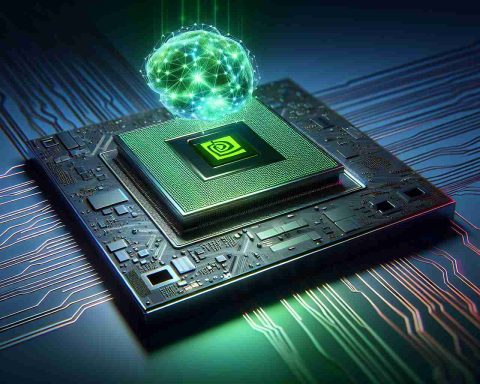- Intel’s stock performance soared unexpectedly by 3.1%, despite broader market declines.
- Co-CEOs Michelle Johnston Holthaus and David Zinsner are leading a strategic transformation, focusing on restructuring Intel’s foundry business.
- The aim is to spin off the foundry business into an independent subsidiary to increase agility against competitors like AMD.
- Intel targets 2025 for market stabilization, with plans to reclaim data center leadership and embrace AI opportunities.
- Potential sales of Mobileye Global stakes and plans to relist Altera highlight Intel’s strategy of collaboration and partnerships.
Intel is capturing headlines with its surprising stock performance, defying market turbulence and sending ripples through the tech industry. While the broader market stumbled with a 0.5% drop in both the S&P 500 and Nasdaq Composite, Intel’s shares soared by 3.1% following pivotal revelations at the Barclay’s Global Technology Conference.
Revolutionizing Intel’s Operational Landscape
Under the transformative guidance of new co-CEOs Michelle Johnston Holthaus and David Zinsner, Intel is embarking on an audacious reorientation. A central tenet of their strategy is a bold restructuring of Intel’s foundry business, potentially spinning it off into an independent subsidiary. This strategic pivot is designed to infuse agility, allowing Intel to sharpen its competitive edge against formidable rivals like Advanced Micro Devices (AMD).
Navigating Market Challenges with Strategic Precision
Intel isn’t just reshuffling internally; it’s also realigning its market focus. Holthaus and Zinsner spotlighted 2025 as a target for market stabilization, with an eye towards reclaiming data center dominance and unleashing new opportunities in the realm of artificial intelligence. This foresight is crucial as Intel charts a course through a fiercely competitive landscape.
Forging Tomorrow: Partnerships and Innovations
Central to Intel’s revitalization are potential sales of stakes in Mobileye Global, a leader in autonomous driving technology, and plans to relist its Altera unit. These moves exemplify Intel’s proactive embrace of collaboration and strategic partnerships, reinforcing its commitment to technological leadership and market innovation.
As Intel positions itself for a tech-driven resurgence, its recalibrated strategies promise a future where innovation leads the charge. By navigating change with foresight and precision, Intel is engineering not just a market comeback, but a reinvention poised for long-term success.
Why Intel’s Strategic Overhaul Could Shape the Future of Technology
Market Forecasts: What’s Next for Intel?
The recent decisions at Intel have prompted analysts to reevaluate the company’s market trajectory. With the planned restructuring of its foundry business, Intel aims to increase its production capacity and streamline operations. Analysts predict that these moves could potentially boost Intel’s market share by up to 20% over the next five years, particularly in the sectors of data centers and artificial intelligence. This optimistic forecast is buoyed by Intel’s aggressive push into AI technologies, indicating a potential dominion over next-gen computing solutions.
Innovations: How is Intel Pioneering New Technologies?
Intel’s strategic alliances and initiatives are paving the way for cutting-edge innovations. One such development is their significant investment in silicon photonics, a technology that uses light to transfer data swiftly within devices. As data demands continue to grow exponentially, this innovation is expected to revolutionize data centers by dramatically reducing energy consumption and increasing the speed of data processing. Additionally, Intel’s collaboration with Mobileye is advancing the future of autonomous vehicles, potentially leading to smarter, safer driving systems.
Security Aspects: What Measures is Intel Implementing?
Security remains a paramount concern in the tech industry, and Intel is taking substantial steps to safeguard its innovations. Recognizing the vulnerabilities that come with technological advancements, Intel has introduced enhanced security protocols within its chips, focusing on hardware-based security measures. These include real-time threat detection capabilities and advanced encryption standards, positioning Intel at the forefront of secure computing solutions.
For more information about Intel’s developments and overall strategy, visit the Intel website.
Related Questions:
1. How does Intel’s restructuring impact its competition with AMD?
Intel’s spin-off of its foundry business and focus on AI and data centers aim to create a more agile and competitive entity. This strategic pivot is expected to sharpen Intel’s competitive edge against AMD, particularly as Intel enhances its capacity and technological prowess in these lucrative markets.
2. What role does Mobileye play in Intel’s future growth?
Mobileye is crucial to Intel’s strategy, spearheading its foray into the burgeoning autonomous vehicles sector. By potentially selling stakes and fostering partnerships, Intel is leveraging Mobileye’s expertise to develop revolutionary self-driving technologies that could yield significant market advantages.
3. How will Intel’s investment in AI affect its long-term prospects?
Intel’s aggressive investment in artificial intelligence not only aligns with current tech trends but also positions the company as a leader in future computing technologies. By integrating AI capabilities across its operations and products, Intel is set to capture a substantial share of this transformative market, impacting its long-term growth and sustainability.
















